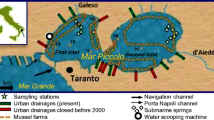Summary
Long term continuous plankton measurements at Helgoland (North Sea) have provided a set of data which could be used for ecological functional analysis with respect to prey predator theory. Local dynamics display trophic feedback between selected populations. Phytoplankton, small copepods, Noctiluca miliaris, Pleurobrachia pileus and Beroe gracilis conform with theoretical assumptions. The functional relationships are less significant in averaged population dynamics compared with single ear processes. The local prey-predator cycles are to be understood as population waves travelling through German Bight. Such population waves over an area of 18 000 km2 have been investigated and are displayed for the above given zooplankton populations as computer graphics and analysed in their progression for the population of P. pileus.
Similar content being viewed by others
References
Bazykin AD (1974) Structural and dynamic stability of model predator-prey systems. IIASA RM-76-8
Biologische Anstalt Helgoland (1963–1986) Jahresberichte. Biologische Anstalt Helgoland, Hamburg
Breen PA, Mann KH (1976) Changing lobster abundance and the destruction of kelp beds by sea urchins. Mar Biol 34:137–142
Fedra K (1981). Pelagic food web analysis: hypotheses testing by simulation. Kieler Meeresforsch SH 5:240–258
Greve W, Reiners F (1980) The impact of prey-predator waves from estuaries on the planktonic marine ecosystem. Estuarine Perspectives Academic Press:405–421
Greve W (1981) Invertebrate predator control in a coastal marine ecosystem: the significance of Beroe gracilis (Ctenophora). Kieler Meeresforsch SH 5:211–217
Greve W (1988) Marine Systemökologie. Loccumer Protokolle (in press)
Kremer JN, Nixon SW (1978) A coastal marine ecosystem simulation and analysis. Springer Berlin Heidelberg New York p 217
Lotka AJ (1925) Elements of physical biology Williams and Wilkins Baltimore, Md. p 460
Ludwig D, Jones DD, Holling CS (1978) Qualitative analysis of an insect outbreak system: the spruce budworm and forest. J Anim Ecol 47:315
Späth H (1973) Spline Algorithmen zur Konstruktion glatter Kurven und Flächen Oldenbourg, München
Vollrath W-M (1985) Graphikunterstützte Validation von Planktonmodellen durch interaktive qualitative Prozeßanalytik. Dipl. Arb. Fachbereich Informatik Universtiät Hamburg p 192
Volterra V (1926) Variations and fluctuations of the number of individuals in animal species living together. J Cons perm int Ent Mer 3:3–51
Uhlig G, Sahling G (1985) Blooming and red tide phenomenon in Noctiluca scintillans. Bull Mar Sci 37:779
Author information
Authors and Affiliations
Rights and permissions
About this article
Cite this article
Greve, W., Reiners, F. Plankton time — space dynamics in German Bight — a systems approach. Oecologia 77, 487–496 (1988). https://doi.org/10.1007/BF00377264
Received:
Issue Date:
DOI: https://doi.org/10.1007/BF00377264




